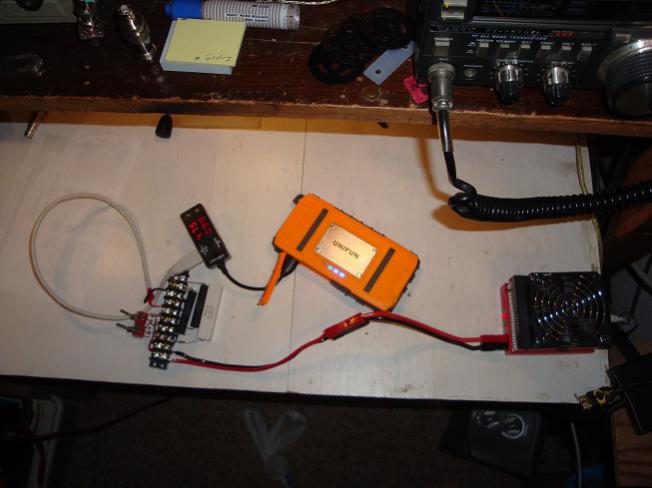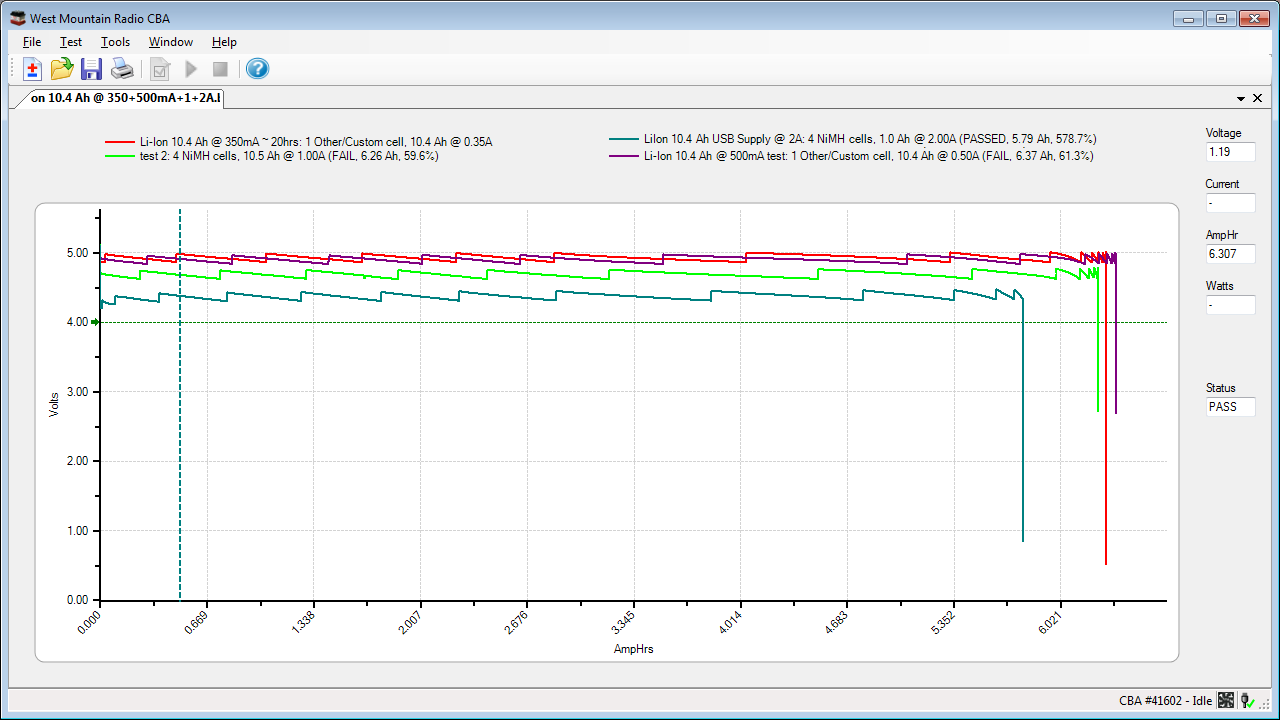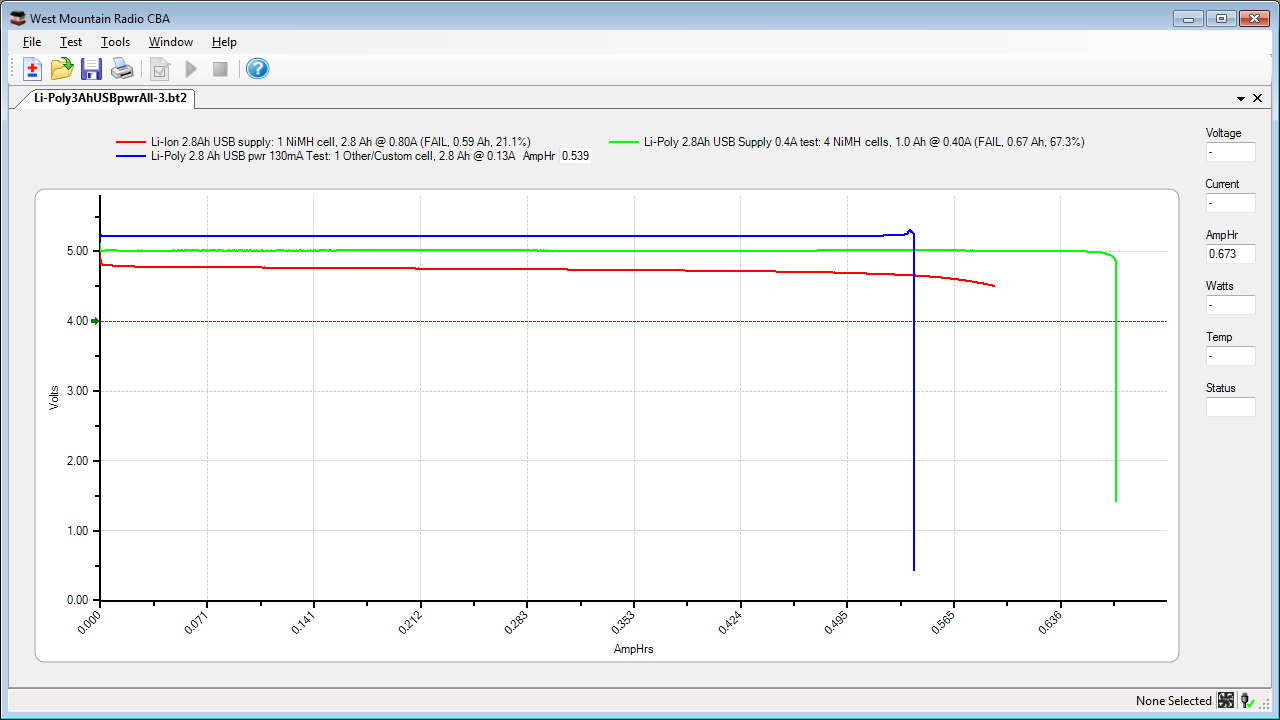I have been given or purchased a number of various USB power banks. These power banks are designed to replace the AC outlet with a USB power supply so that when you’re in the field and do not have access to an AC outlet, you can still charge or power your USB powered device The ubiquitous cell phone is our main USB powered/charged device, but there are other things, such as Bluetooth speakers, which also require a 5 Volt power source to recharge.
But, what does it mean to have a 10 amp-hour (Ah) USB power bank?
When testing batteries for amp-hour ratings, the battery is expected to be able to run down to ~ 80% of its nominal voltage and still be able to be properly recharged. So, 80% of a 12V is ~ 10.5 Volts. Actually, 80% of 12V is about 9.6V, but since a 12V battery is really a 12.6V battery and the cut off is usually considered to be around 10.5V, this comes out to ~ 83%.
The Ah rating is normally found by running the battery down to ~ 80% of its nominal voltage with a current 1/20th of its designated Ah rating. This may be somewhat circular since if we don’t know the Ah rating, how can we determine the testing current of 1/20 of its Ah rating? I will leave that to the manufacturers to determine, since I assume it is by trial and error that the rating for any one particular new battery is determined.
We don’t have that problem, we only have to test the battery at 1/20th the printed rating on the battery to see if it will stay above 80% of its voltage after 20 hrs, which means it passed and is at least that Ah rating. This is not the way we normally use a battery. This is only the way the manufacturers have agreed to test the batteries they make.
Now, here’s the problem. The USB power standard is that it will supply the rated current at 4.75 to 5.25 Volts. If the voltage falls below 4.75V, the USB power source is considered out-of-specification and the USB powered device may not function correctly. Yet, 4.75V is 95% of 5V and ~ 90% of 5.25V, so right off we have a conflict of definitions.
The question is then how have the various USB power bank manufacturers decided to define their Ah ratings, especially when they say the device is a 10 Ah USB power bank. I would expect that the device would then supply one amp for 10 hours or two amps for about 5 hours. This is not how the Ah rating of a battery is defined, so how is it calculated? My guess is that they are not using an amp-hone rating based on the USB five Volt specification but simply on the internal Li battery.
I tested two such devices I have, one being a UNIFUN 10400 mAh (10.4 Ah) power bank the other being a 2 Ah power bank. and since the 10 Ah bank came with two ports, one supplying 1 amp and the other able to supply 2 amps I tested both ports at their specified max current rating.
If this were simply a battery, I would expect the voltage to gradually decrease until it went below the USB cutoff voltage of 4.75V. But, since I know of no battery that can start at 5 – 5.25 Volts and maintain a voltage above or at 4.75V, I was curious to see what was going on.
What I found with the 10.4 Ah device is that the manufacturer has a circuit inside the device that keeps the voltage above 4.75Volts until the internal battery falls below some minimum safe voltage. Once that happens, the USB power is shut off by a safety circuit.
In the case of a 3.7V Li-Ion battery, this means the voltage is allowed to drop to around 3.1 – 3.4V because the battery is usually charged to just below 4.2 Volts but its chemistry nominal voltage is considered to be about 3.7V. We don’t need to know any of that to test our power bank, but it’s good to have some idea of what is going on in the power bank.
The output voltage of the 10.4V power bank fluctuated in a saw tooth pattern from about 4.95V down to 4.75V. At that time, the circuit cut in to boost the voltage back up to ~5V. The test graphs show the voltages to be ~ 0.11 lower than what I have stated because of the test setup.

In this setup we see the yellow power bank with a USB V/A (USB Voltage/Current measuring device) plugged into it, then going to a resistor switch bank, which is presently bypassed to feed directly into the computerized battery analyzer on the right side of the photo. The voltage and current, as displayed on the USB V/A meter, are 4.75V and 0.99A, while on the display of the computer it says 4.64V and 1.00A. I suspect that the added wire and connections added a bit of resistance and thus a voltage drop going to the CBA IV. Nevertheless, the device is putting out a voltage within the USB standard at the specified current. The CBA will tell us how long the power bank was able to supply 1A from the 1A USB port before the protection circuit shut off the power to the 1A USB port.
NOTES:
After ~ four hours the lowest voltage got down to 4.72V on the USB V/A meter.
The results of the 1A test is the green line in the graph below. Result = 6.26 Ah
Graph 1: Li-Ion 10.4 Ah Power Bank tested at 0.35, 0.50, 1.00, & 2.00 Amps.

As can be seen on the above graph, the unit tested to be about a 6.26 Ah USB power bank when attached to a 1A drain device. Do not worry about the “FAIL” rating since we’re simply trying to determine exactly what it means when a device such as a USB power bank is rated at some amp-hour rating.
10.4 Ah Power Bank 2A Test (The turquoise curve above):
I recharged the 10.4 Ah power bank over the evening and when fully charged, disconnected it from the charger. The next test done was the smaller 2.8 Ah power bank, then the 2A test was done for the 10.4 Ah power bank.
With this test, the voltage drop was greater. It was around 0.24V less on the CBA IV test device compared to the output of the USB power bank and the voltage. Even measured right at the power bank, it was lower than 4.75V most of the time. Being a two-amp test, if batteries were linear devices, one would expect the power bank to last less than half the 1A drain rate, or less than ~3.13 Ah. However, since the Ah rating of a battery does not follow a linear decrease, we’re never sure what it will test for higher, or lower, currents. The results are shown in the graph above. The rating was measured to be 5.79 Ah or ~ 2h 54 min.
The next test done with this power bank was run at 500 mA (the purple curve above) and it should be close to the claimed 10.4 Ah but was measured at only 6.37 Ah. This means that it was only running for about 12 hrs 45 min., not the expected 20 hours.
One last test was done running the unit at 350 mA. If it lasts for 20 hours, that would mean the rating of this unit would be ~ 7 Ah. In the graph above, this test is shown by the red curve. This test was a little lower than the 500 mA test coming in at ~6.31 Ah.
The conclusion is that this device is not a 10.4 Ah USB power source. It is close to a 6.3 Ah device, since running it at 350mA, 500mA, & 1 A shows that it is consistently in the 6.2 – 6.3 Ah range which is quite acceptable but certainly not 10.4 Ah. The 2A test came in at about 5.8 Ah and that’s more than acceptable for a 6.3 Ah power bank.
2.6 Ah, 5.5V Power Bank 800 mA Test:
This power bank claimed that the output port would supply 5.5V and that the max output current was supposed to be 800 mA. This power bank was first tested at the 800 mA current, then recharged and tested at both 400 mA and then at 130 mA. The computed 20 hours discharge rate for a claimed 2.8 Ah battery would be 140 mA, but when I entered the test parameters I goofed and entered 130 mA. Still, this is very close to 140 mA and if the battery was good and this device acted like a 2.8 Ah battery, it should have tested at a bit better than 2.8 Ah. It did not.
The results were very disappointing because all tests rated the unit at much less than a 1 Ah power bank. While all ratings were close, even the best was only 0.637 Ah (637 mAh) for less than 23% of its claimed rating. The best test was at 400 mA (the green curve) with a rating of 0.637 Ah. Next was the 800 mA test (the red curve) at 0.59 Ah, but if I had tested this to the same 4 Volt cut-off voltage, it probably would have come closer to around 6.1 A. The next surprise was that the 130 mA test was actually worse than the other two, coming in at only 0.539 Ah. I think this clearly indicates that the battery in this device has failed and is getting worse the more I test it.
While this device’s output voltage never reached its claimed 5.5 Volts, it did get higher when the current was lower, and perhaps with a good battery it would have reached the 5.5 V claimed design specification.
The results of all tests are shown below on the combined graph:
Li-Polymer 2.8 Ah Power Bank 130, 400, & 800 mA Tests

Also interesting was the difference in how the two devices tried to meet the USB voltage requirement. In the 10.4 Ah device, we see a saw-tooth performance as the voltage dropped to about 4.75 Volts and. Then the voltage boosting circuit changed its parameters to once again bring the voltage back up to about 5.00 Volts. The 2.8 Ah device tried to maintain as close to 5.5 Volts as it could. It came closest to 5.5 Volts at the lower current used for a test (the 130mA test), where the voltage was about 5.2 V. At 400 mA it was 5.01 V, and at 800 mA it was lower. The current drain was only around 4.75 V.
I’m not concerned about the voltage drop for any USB Power Bank since I figured, as a charging device, it is supplying the required voltage at its output and it is the responsibility of the device needing to be charged to supply a USB cable capable of supplying the required Voltage and current needed. Unless, the voltage at the ouput port of the power bank is below the USB specification.
Neither of these devices met their published specifications. The 10.4 Ah USB power bank didn’t come close to supplying 10.4 Ah at the normal 1/20 test current, which is the current used to discharge batteries for 20 hours at or above the drop-out voltage. So, what does this mean? I think it clearly indicates that the rating given is for the internal battery and not for the over-all power bank.
The 2.8 Ah power bank did not meet its published voltage output value of 5.5 Volts. It did maintain a voltage of about 5.2 Volts, but only when tested with 130 mA. I have already surmised that the poor results of this power bank are due to an old and failing battery.
My guess is that no matter what the manufacturer says about their USB power bank, you can figure that you will get only around 50 – 60% the charging time claimed. So, for a 10.4 Ah device figure it will be able to supply 1 Amp for about 5.2 – 6.2 hours. This means that if your phone is a 2 Ah device, you will probably be able to charge it twice with this 10.4 power bank but probably not three times. This is all probably due to using a 3.7 V Li battery and boosting the voltage to ~ 5 Volts, plus having safety circuits monitoring the internal battery so it doesn’t over heat or get too low in voltage. All of this uses some battery energy/power which is then unavailable to charge your device.
I contacted the manufacturer and told them of my test results and their response was as follows:
From: UNIFUN – Amazon Marketplace <[email protected]>
To: “[email protected]” <[email protected]>
Sent: Thursday, October 19, 2017 5:29 AM
Subject: Product details inquiry from Amazon customer Phil Karras…Dear Phil Karras,
Thanks for contacting us.
From your description, I understand that the power bank is (actually) a 6270 mAh or ~ 6.26 Ah device, (there) is nothing wrong with your test, this is just the way the calculation is not the same. (… just the way the calculations work out. -pk)
The 10400mAh is the cell capacity, the voltage of the cell is 3.7V, so the rated energy of this power bank is 10400mAh*3.7V=38.4Wh.
But the voltage of the phone is 5V, according to the law of conservation of energy, in order to charge your phone, the voltage should be promoted to 5V, so the rated capacity of this power bank under 5V is 38400mWh / 5V = 7680mAh.
But 7680mAh is not the final power that the phone gets, when the power bank charges your phone, the circuit board boost and the operation of the security chip will lose part of the energy. If the power bank conversion rate of 84%, 7680mAh * 84%= 6451mAh, but the transmitted power will be treated with a step-down at the phone, this will lose part of the power, this is why a lot of mobile phones in the charging process will be hot.
Do hope this can help you, if any query, feel free to contact me, I will be glad to help you.
Yours,
Amy
Amy’s technical information is in line with my findings. If the battery inside is a Lithium battery of some kind, then its nominal operating voltage is 3.7 V. Thus there needs to be a boosting circuit to get it to the USB standard of 4.75 to 5.25 Volts. The best switching power supplies are about 90% efficient so we lose at least 10% in this circuit. Next, there needs to be a voltage monitoring circuit and a protection, low-voltage shut-off circuit, I believe Amy called this the “Security” circuit. All of this, she says, reduces the amp-hour rating to about 62%. The big “loss” is from the conservation of energy she mentioned. This is “simple” physics, meaning we have the same power going from 3.7 Volts to 5 Volts but the Ah rating is reduced: P=IV or Power (Watts) = Current (Amps) times V (Volts). Amy shows us that the power of the 10.4 Ah unit is: P = IV = 10.4 A * 3.7 V = 38.5 Wh. Now we can’t gain or lose power, so when the 3.7 V is converted to 5 Volts the Amps have to decrease so we have (I = P/V) or, following the units, we see: Ah = Wh / V. Using the numbers, we have 38.5 Wh / 5 V = 7.7 Ah. Amy then tells us that the additional circuitry (the voltage inverter and security circuit) reduces the deliverable energy to only 84%. So of the possible Ah of 7.7 AH we only get 84% of that at the required 5V, or about 6.5 Ah.
Looking at my experiments the best I got was at around 500 mA at 6.4 Ah. (The best was 6.37 Ah) which for experimental to match theoretical is extremely good.
Also note, when charging a 3.7V Li battery, there is another set of circuits inside your phone or other device to change the 5V into the needed voltage and another circuit to protect the battery, such as a high voltage cut-off and temperature-monitoring safety circuit, so we’re probably reduced to about 84% yet again.
So here’s my rough rule-of-thumb: Take whatever the Ah rating is stated to be on the USB power device then figure that the best deliverable power/energy will be about 50% of that.
Thus, the 10.4 Ah will be able to charge a 2 Ah cell battery 10.4 * .5 = 5.2 Ah and then 5.2 Ah / 2 Ah = 2.6 times. Round that down and it might just be able to charge it from full depletion to full charge two times. I always round down when figuring things like this to be on the “safe” side. In an emergency, it’s always better to have more power than you figured on rather than less.
For a 5 Ah USB power bank, we can see that this comes close to ~ 1.5 times, probably only once for a 2 Ah phone battery and if that battery, is 2.7 – 3 Ah, this USB power bank will manage to charge the cell battery once as long as it is not fully depleted.
If we want to be ready for that power outage that will last for days or weeks, we need as much power as possible and a way to recharge our batteries as well. A 16 Ah USB power bank will give us ~ 8 Ah, for a 3 Ah Cell battery we get ~ 2.6 times, and for a 2 Ah cell battery we might get 4 full recharges (but probably only three).
I hope this helps explain what we can expect from a USB power bank when all we can see is the Ah rating of the Li battery inside and not what it really means for actual recharging and/or usage with a device that requires 5 Volts.





